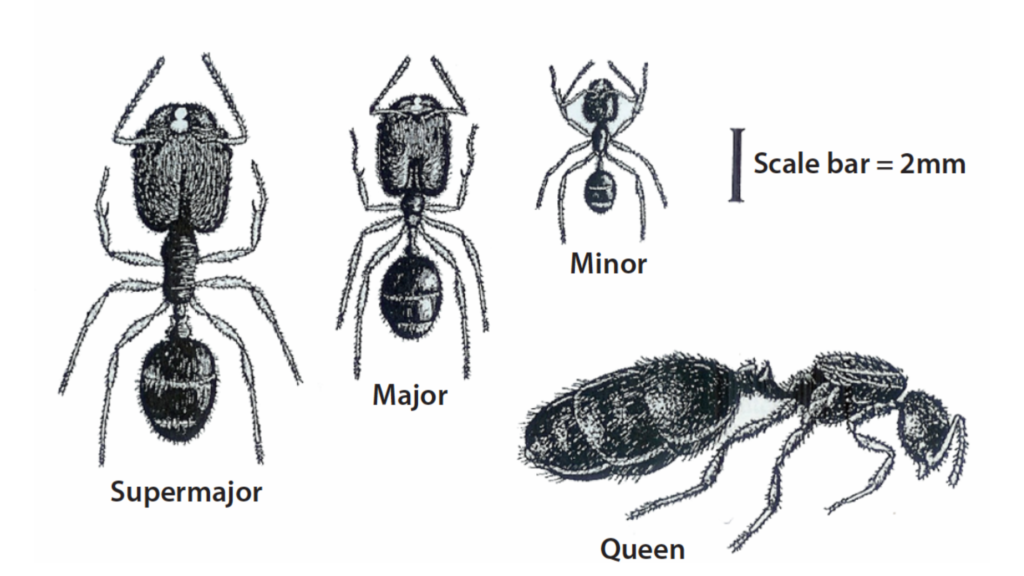What is a Big-Headed Ant?
Big-headed ants are a species of ants with unique characteristics. Can you guess what it is? That’s right – their heads are gigantic! The big-headed is polymorphic, meaning it has multiple types of forms including queens, males, supermajors, majors, and minors. Each type plays its own role within the colony. The scientific name for the big-headed ant is Pheidole rhea.
Where Do They Live?
Much like our other animal ambassadors in the Hidden Life of Desserts, big-headed ants can be found throughout desserts in the southern United States and through parts of Mexico. These ants are becoming an invasive species in places such as Florida. An invasive species is a species that is not native to the region and is causing some form of ecological harm to the new environment. These species are often introduced through human actions or natural dispersals, such as weather.

We can see big-headed ants taking shelter at the Hidden Life of Deserts exhibit. This species, which can be seen at WonderLab, live a substyleterranean life as they crawl through the sand of the desert biome, nesting underground in the soil. Without the threat of the sun, ants can find shade underground and enjoy the water that is unable to evaporate quickly. Living a subterranean lifestyle also allows ants to store food and hide from any predators that may be on the hunt!
Ants at Work
Big-headed ants are an example of a caste-based social structure at work. A caste is a group of animals that are social and live within a colony. Animals within a caste system are typically born with physical features that determine the role the organism will play within the society. Each of the various shapes is known as a caste and determines the role the ant will play in the community. The form of various ants allows the ant to have ideal anatomy regarding their designated task.

Minor workers are relatively small and are responsible for being the caregivers of the community. Their tiny bodies allow them to be agile enough to care for delicate tasks such as foraging for food, scouting territories, cleaning the colony, and tending to the queen.
The queen’s main responsibilities include founding a new colony and laying eggs. The queen can produce over 250 eggs per month! She can be identified as being much larger than the other ants in her colony. Despite her royal title, the queen ant does not order the other ants to do tasks for her.
By having a labor division system, ants can streamline the work in the community, maximizing efficiency. To learn more about how insects utilize caste systems, be sure to visit the honeybee exhibit here at WonderLab!
Sources
Bigheaded ant – Pheidole megacephala (Fabricius). (n.d.). Entomology and Nematology Department. Retrieved March 1, 2022, from https://entnemdept.ufl.edu/creatures/urban/ants/bigheaded_ant.htm
Big-Headed Ant, Pheidole sp. (n.d.). Urban and Structural Entomology Program at Texas A&M University. Retrieved March 1, 2022, from https://urbanentomology.tamu.edu/urban-pests/ants/big_headed/
Carthy, N. (2011, March 24). Invasive Species. National Geographic Society. Retrieved March 1, 2022, from https://www.nationalgeographic.org/encyclopedia/invasive-species/
caste | biology | Britannica. (n.d.). Encyclopedia Britannica. Retrieved March 1, 2022, from https://www.britannica.com/science/caste-biology
Castes – Entomologists’ glossary. (n.d.). Amateur Entomologists’ Society. Retrieved March 1, 2022, from https://www.amentsoc.org/insects/glossary/terms/castes/
The Secrets of Royalty: Amazing Facts About Queen Ants. (n.d.). Terro. Retrieved March 1, 2022, from https://www.terro.com/articles/queen-ants



Leave A Comment